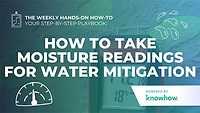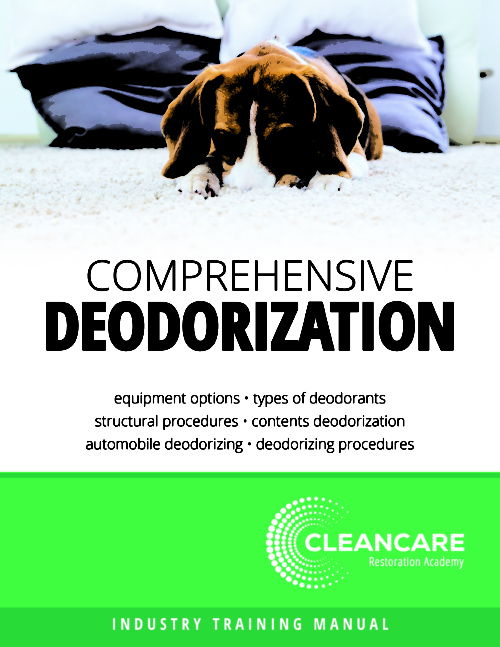Weekly Hands-on How-To powered by KnowHow
How To Handle Common Problems on Mold Mitigation Jobs

All images provided by KnowHow.
In mold remediation you’re balancing timelines, homeowner expectations, and the unexpected surprises that come with every job. Maybe the water source wasn’t fixed before you arrived, or a homeowner accidentally unplugged your equipment. Sometimes, containment gets breached, or you uncover more mold than anyone expected.
These challenges aren’t just frustrating—they can derail your progress and risk the success of the project if not handled properly. But with the right approach, and a solid understanding of the common roadblocks, they don’t have to.
In this weekly how-to, powered by KnowHow, we’ll walk you through some of the most common issues that come up during mold remediation. From preventing setbacks to managing unexpected discoveries, this guide will help you tackle these challenges head-on and keep your projects running smoothly. Let’s get started!
Step 1: Water Source Is Not Fixed
A water leak is often the root cause of mold growth, and failing to address it will lead to recurring issues. Fixing the water source is a non-negotiable step in ensuring long-term success for any remediation effort. Without this, even the best remediation work will not give lasting results.
Solution:
- Alert the homeowner and management immediately.
- Stress the importance of fixing the water source to prevent mold from returning.
- Document the communication and adjust timelines as needed.

Step 2: Homeowner Not Home for Appointment
Scheduling conflicts happen, and when the homeowner isn’t available, it can disrupt the workflow and delay progress. Flexibility and proactive communication are key to managing these situations without derailing the project.
Solution:
- Contact the homeowner: Reach out via phone or email to inform them and reschedule.
- Reschedule the appointment: Coordinate a suitable time and date.
- Communicate the new schedule: Provide updated details and instructions.
- Document communication: Keep records for clarity and accountability.
- Adjust the timeline: Revise the project schedule to account for the delay.
Step 3: Homeowner Opened Containment
Containment zones are critical for preventing mold spores from spreading to unaffected areas. When a homeowner unknowingly disrupts the containment, the integrity of the remediation process is at risk.
Solution:
- Communicate the importance of keeping containment sealed.
- Reseal the containment area to restore the controlled environment.
- Place warning signs to discourage further interference.
- Document the incident and educate the homeowner to prevent recurrence.

Step 4: Additional Mold Found During Demo
Demolition can reveal hidden surprises, including mold growth that wasn’t visible during the initial assessment. These discoveries can expand the scope of the project and require careful handling to avoid further contamination.
Solution:
- Pause work and notify your supervisor.
- Contact the Environmental Hygienist (if applicable) to update the protocol.
- Assess the additional mold and adjust the project scope as needed.
- Follow safe removal and disposal guidelines to mitigate risks.
Step 5: Homeowner Has Turned Off or Unplugged Equipment
Running equipment like dehumidifiers or air scrubbers is critical to mold remediation, and interruptions can undermine the entire process. When a homeowner turns off or unplugs equipment, it’s essential to address the issue calmly and ensure understanding.
Solution:
- Explain the importance of continuous equipment operation to the homeowner.
- Provide clear instructions on how and why the equipment should remain running.
- Address any questions or concerns to avoid future interruptions.
Step 6: Employee Injured on the Job
Even with safety measures in place, accidents can happen on the job. Prompt and professional handling of injuries ensures the well-being of the employee and maintains compliance with company protocols.
Solution:
- Notify your supervisor immediately and provide necessary first aid.
- Follow company procedures for reporting and documenting the injury.
- Ensure the employee receives appropriate medical care and support.
Confidently Tackle Mold Remediation Challenges with KnowHow
Whether it’s addressing a water source, resealing containment, or managing additional mold discovered mid-project, following these processes helps keep your remediation work on track and successful.
But let’s be honest—remembering every protocol, especially under pressure, isn’t always easy. That’s where KnowHow makes all the difference. With instant access to step-by-step guidance, real-time support, and company-specific SOPs, your team can handle challenges with confidence and precision every time.
Empower your crew to work smarter, safer, and more efficiently. Visit tryknowhow.com today to see how we can help you streamline every step of your restoration projects.
Looking for a reprint of this article?
From high-res PDFs to custom plaques, order your copy today!







